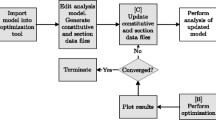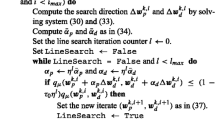Abstract
Design of composite laminated lay-ups are formulated as discrete multi-material selection problems. The design problem can be modeled as a non-convex mixed-integer optimization problem. Such problems are in general only solvable to global optimality for small to moderate sized problems. To attack larger problem instances we formulate convex and non-convex continuous relaxations which can be solved using gradient based optimization algorithms. The convex relaxation yields a lower bound on the attainable performance. The optimal solution to the convex relaxation is used as a starting guess in a continuation approach where the convex relaxation is changed to a non-convex relaxation by introduction of a quadratic penalty constraint whereby intermediate-valued designs are prevented. The minimum compliance, mass constrained multiple load case problem is formulated and solved for a number of examples which numerically confirm the sought properties of the new scheme in terms of convergence to a discrete solution.










Similar content being viewed by others
Notes
Carbon fiber reinforced polymer.
Glass fiber reinforced polymer.
References
Abrate S (1994) Optimal design of laminated plates and shells. Compos Struct 29(3):269–286
Ahmad S, Irons B, Zienkiewicz O (1970) Analysis of thick and thin shell structures by curved elements. Int J Numer Methods Eng 2:419–451
Bendsøe M (1989) Optimal shape design as a material distribution problem. Struct Multidisc Optim 1(4):193–202
Bendsøe M, Kikuchi N (1988) Generating optimal topologies in structural design using a homogenization method. Comput Methods Appl Mech Eng 71(2):197–224
Bendsøe M, Sigmund O (1999) Material interpolation schemes in topology optimization. Arch Appl Mech 69:635–654
Bendsøe M, Sigmund O (2003) Topology optimization: theory, methods, and applications. Springer, New York
Bendsøe M, Díaz A, Lipton R, Taylor J (1995) Optimal design of material properties and material distribution for multiple loading conditions. Int J Numer Methods Eng 38(7):1149–1170
Bodnár G (2009) Visualization and interpretation tools for free material optimization results. In: 8th world congress on structural and multidisciplinary optimization. Lisbon, Portugal
Borrvall T, Petersson J (2001a) Large-scale topology optimization in 3D using parallel computing. Comput Methods Appl Mech Eng 190(46–47):6201–6229
Borrvall T, Petersson J (2001b) Topology optimization using regularized intermediate density control. Comput Methods Appl Mech Eng 190(37–38):4911–4928
Bruyneel M, Duysinx P (2006) Note on singular optima in laminate design problems. Struct Multidisc Optim 31(2):156–159
Cherkaev A (1994) Relaxation of problemss of optimal structural design. Int J Solids Struct 31(16):2251–2280
Duysinx P, Bendsøe M (1998) Topology optimization of continuum structures with local stress constraints. Int J Numer Methods Eng 43(8):1453–1478
Fukunaga H, Vanderplaats G (1991) Strength optimization of laminated composites with respect to layer thickness and/or layer orientation angle. Comput Struct 40(6):1429–1439
Gibiansky L, Sigmund O (2000) Multiphase composites with extremal bulk modulus. J Mech Phys Solids 48(3):461–498
Gill P, Murray W, Saunders M (2005) SNOPT: an SQP algorithm for large-scale constrained optimization. SIAM Rev 47(1):99–131
Gill P, Murray W, Saunders M (2008) User’s guide for SNOPT version 7: software for large-scale nonlinear programming. Department of Mathematics University of California, San Diego, La Jolla, CA, pp 92093–920112
Gürdal Z, Haftka R, Hajela P (1999) Design and optimization of laminated composite materials. Wiley-Interscience, New York
Hörnlein H, Kočvara M, Werner R (2001) Material optimization: bridging the gap between conceptual and preliminary design. Aerosp Sci Technol 5(8):541–554
Kohn R, Strang G (1982) Structural design optimization, homogenization and relaxation of variational problems. In: Macroscopic properties of disordered media, pp 131–147
Kohn R, Strang G (1986) Optimal design and relaxation of variational problems. Commun Pure Appl Math 39:1–25 (Part I), 139–182 (Part II), 353–357 (Part III)
Lund E (2009) Buckling topology optimization of laminated multi-material composite shell structures. Compos Struct 91(2): 158–167
Lund E, Stegmann J (2005) On structural optimization of composite shell structures using a discrete constitutive parametrization. Wind Energy 8(1):109–124
Lurie K (1980) Optimal design of elastic bodies and the problem of regularization. Wiss Z - Tech Hochsch Leipz 4:339–347
Mateus H, Soares C, Soares C (1991) Sensitivity analysis and optimal design of thin laminated composite structures. Comput Struct 41(3):501–508
Panda S, Natarajan R (1981) Analysis of laminated composite shell structures by finite element method. Comput Struct 14(3–4):225–230
Pedersen P (1989) On optimal orientation of orthotropic materials. Struct Multidisc Optim 1(2):101–106
Pedersen P (1991) On thickness and orientational design with orthotropic materials. Struct Multidisc Optim 3(2):69–78
Rozvany G, Zhou M, Birker T (1992) Generalized shape optimization without homogenization. Struct Multidisc Optim 4(3): 250–252
Schmit JL, Farshi B (1973) Optimum laminate design for strength and stiffness. Int J Numer Methods Eng 7:519–536
Setoodeh S, Gürdal Z, Abdalla M, Watson L (2004) Design of variable stiffness composite laminates for maximum bending stiffness. In: 10th AIAA/ISSMO multidisciplinary analysis and optimization conference
Sigmund O, Torquato S (1997) Design of materials with extreme thermal expansion using a three-phase topology optimization method. J Mech Phys Solids 45(6):1037–1067
Stegmann J, Lund E (2005) Discrete material optimization of general composite shell structures. Int J Numer Methods Eng 62:2009–2027
Stolpe M, Stegmann J (2008) A Newton method for solving continuous multiple material minimum compliance problems. Struct Multidisc Optim 35(2):93–106
Stolpe M, Svanberg K (2001) An alternative interpolation scheme for minimum compliance topology optimization. Struct Multidisc Optim 22(2):116–124
Sun G, Hansen J (1988) Optimal design of laminated-composite circular-cylindrical shells subjected to combined loads. J Appl Mech 55:136
Svanberg K (1994) On the convexity and concavity of compliances. Struct Multidisc Optim 7(1):42–46
Thomsen J, Olhoff N (1990) Optimization of fiber orientation and concentration in composites. Control Cybern 19:327–341
Zenkert D (1997) The handbook of sandwich construction. Engineering Materials Advisory Services Ltd
Acknowledgements
The authors wish to thank José Pedro Albergaria Amaral Blasques and Eduardo Muñoz, Technical University of Denmark, for fruitful discussions and ideas for challenging benchmark examples. This research is part of the “Multi-material design optimization of composite structures”-project sponsored by the Danish Research Council for Technology and Production Sciences (FTP), Grant no. 274-06-0443, this support is gratefully acknowledged.
Author information
Authors and Affiliations
Corresponding author
Rights and permissions
About this article
Cite this article
Hvejsel, C.F., Lund, E. & Stolpe, M. Optimization strategies for discrete multi-material stiffness optimization. Struct Multidisc Optim 44, 149–163 (2011). https://doi.org/10.1007/s00158-011-0648-5
Received:
Revised:
Accepted:
Published:
Issue Date:
DOI: https://doi.org/10.1007/s00158-011-0648-5




